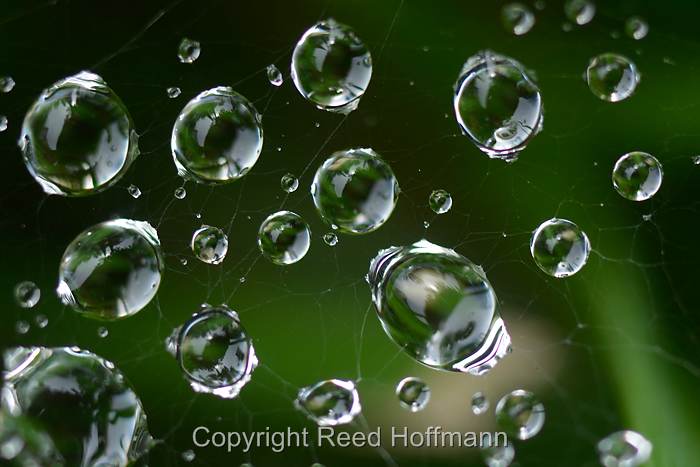I used to think cutting grass was fun. Maybe it was because dad bought a riding mower and that was the closest thing I had to a car then. But for the last thirty years, it’s just been a chore. So when I opened the garage to cut the grass a couple of days ago, I was easily distracted by some water droplets in the grass. Taking pictures of those was WAY more fun than mowing.
If you’re into photography, you tend to pay more attention to what’s around you. For me that means not just seeing the big picture, but looking for the details, too. I like to say that we have wide-angle eyes, so we need to use our mind to zoom in on the little things that might make good pictures. That’s what happened when I went out to cut the grass.
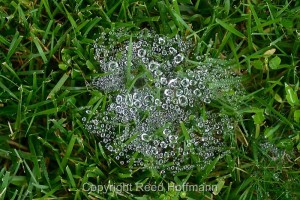
Here’s what the little patch of grass and water droplets looked like as I got close to it. Nikon D5200 set to white balance of SUNNY and ISO of 200, shutter speed of 1/80 at f/4.5, with exposure compensation at -0.7, 105mm lens. Photo copyright Reed Hoffmann.
Human vision is drawn to areas of brightness. It was that brightness that caught my eye as I walked out of the garage – glistening dots in the grass. Turns out they were a bunch of little water droplets. I thought, “Hmmm, cut the grass or go get a camera?” Returning with the camera, I also brought along my Nikon 105mm Micro lens. Most manufacturers call their close-up lenses “Macro,” but Nikon chooses to call theirs “Micro.” Whatever it’s called, it means a lens that focuses closer than most lenses. Some, like this one, can achieve what’s called a 1:1 reproduction ratio. That means it can capture a small object at the same size on the sensor as it is in real life. Close-up lenses generally range in focal length from 40mm to 200mm. The advantage of a longer lens (like my 105mm) is you don’t have to get as close to the subject.
As I knelt in the grass and started shooting, I had one immediate problem. My shutter speed was too low, around 1/30 second. Focused so close like that, and shooting hand-held, I’d probably get blurry photos. Raising the ISO to 400 resulted in a faster shutter speed. That, combined with shooting a lot of frames, insured I’d get a few good ones. Now, cut the grass or go look at my pictures?
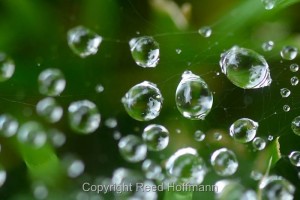
The Micro lens let me get really close. But I had to raise the ISO to get a faster shutter speed, though still not as fast as I’d like. Nikon D5200 set to white balance of SUNNY and ISO of 400, shutter speed of 1/60 at f/5.6, with exposure compensation at -0.7, 105mm lens. Photo copyright Reed Hoffmann.
A few minutes later I was going through the images on the computer. And wasn’t satisfied. The pictures were fine, but that’s not good enough. As I looked at them I realized two things: one, I needed to get closer. And two, I wanted to be able to shoot at a lower ISO, which would mean slower shutter speeds. That meant using a tripod.
The tripod was the easy part. I grabbed the compact Slik carbon-fiber I like to travel with. The center post can be removed, which lets me drop it almost to ground level. Getting closer with the lens was a bit more complicated. I couldn’t focus any closer the way it was, which meant I needed an extension tube.
Extension tubes, not surprisingly, “extend” the distance of the rear-element of the lens from the sensor. By doing that, the lens is then able to to focus closer than normal. They’re simple devices – a tube with no glass inside – are inexpensive and can be used with most lenses. I’ll often put an extension tube in my bag if I don’t want to carry a close-up lens, but might want to shoot some close-ups. They come in differing lengths, longer letting you focus closer. My set of three are 12mm, 20mm and 36mm, and I use them regularly on my 50mm and zoom lenses.
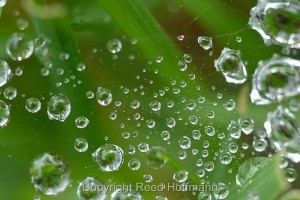
With an extension tube added to the lens, I could start zeroing in on some of the tiny droplets. Nikon D5200 set to white balance of SUNNY and ISO of 200, shutter speed of 1/50 at f/8, with exposure compensation at -0.7, 105mm lens. Photo copyright Reed Hoffmann.
I started with the shortest and worked my way up to the 36mm, as the closer I got the more interesting the picture became. And that’s another thing you always want to try when making pictures – frame your picture as tightly as possible. Most photos are improved that way, by minimizing other distractions in the image area.
The tripod let me shoot at slower shutter speeds, but more importantly, helped me carefully frame and focus the image. When shooting close-ups, you have little-to-no depth of field. It’s very, very easy to be out of focus.
In many ways, this shoot was no different than most I do. First I had to solve the technical issues, in this case exposure and focus. Once those were taken care of, I could concentrate on the creative side, trying to make an interesting picture. That meant looking for patterns among the droplets, watching how the reflections changed as I moved the camera’s position. And the entire time I marvelled at how different tiny things look when you magnify them. That’s one reason I love shooting close-ups.
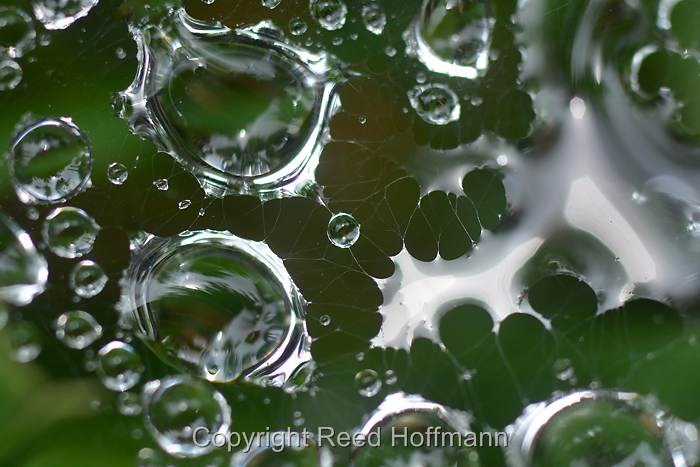
This ended up being my favorite. I loved the tiny droplet suspended in the webs and the interesting reflections. Nikon D5200 set to white balance of SUNNY and ISO of 125, shutter speed of 1/80 at f/8, with exposure compensation at -1.0, 105mm lens. Photo copyright Reed Hoffmann.
There was a penalty to be paid for taking time out to shoot those droplets. By the time I got around to cutting the grass, it was raining. But this time I didn’t mind cutting the grass, or even getting wet doing it. Finding those drops when I first came out, and the pictures that resulted, made it all worthwhile. Even without a riding mower.

